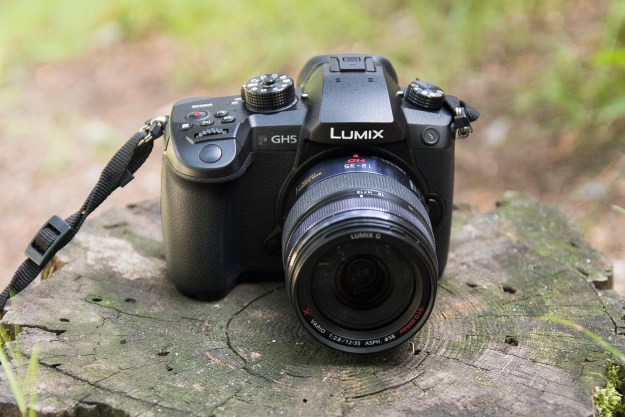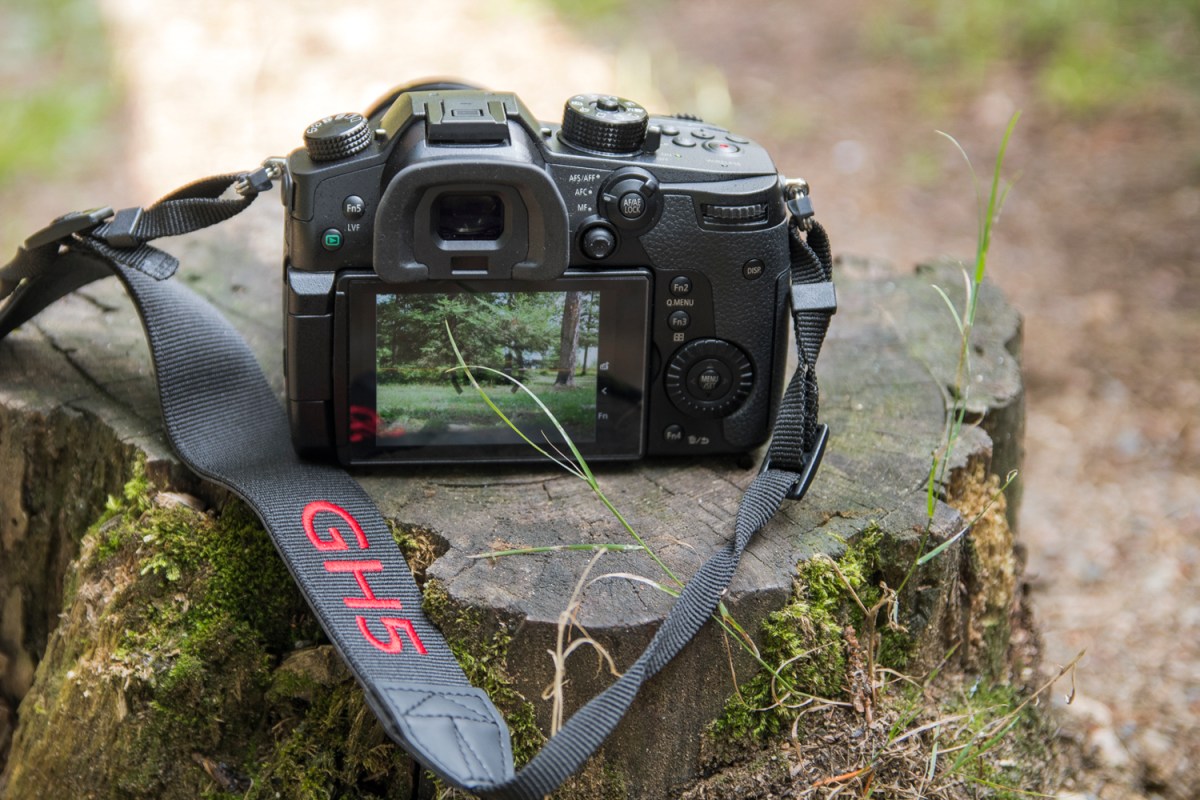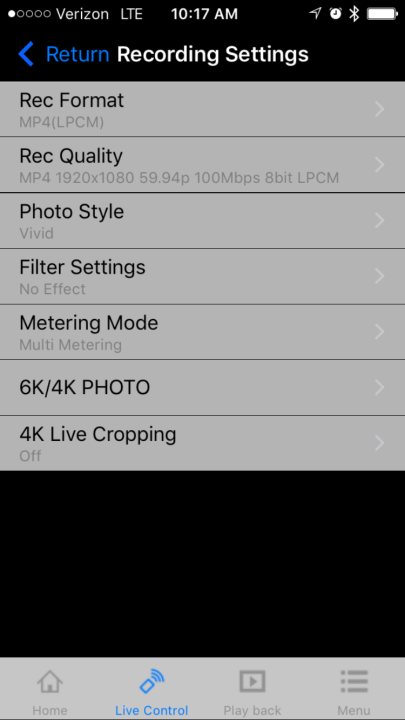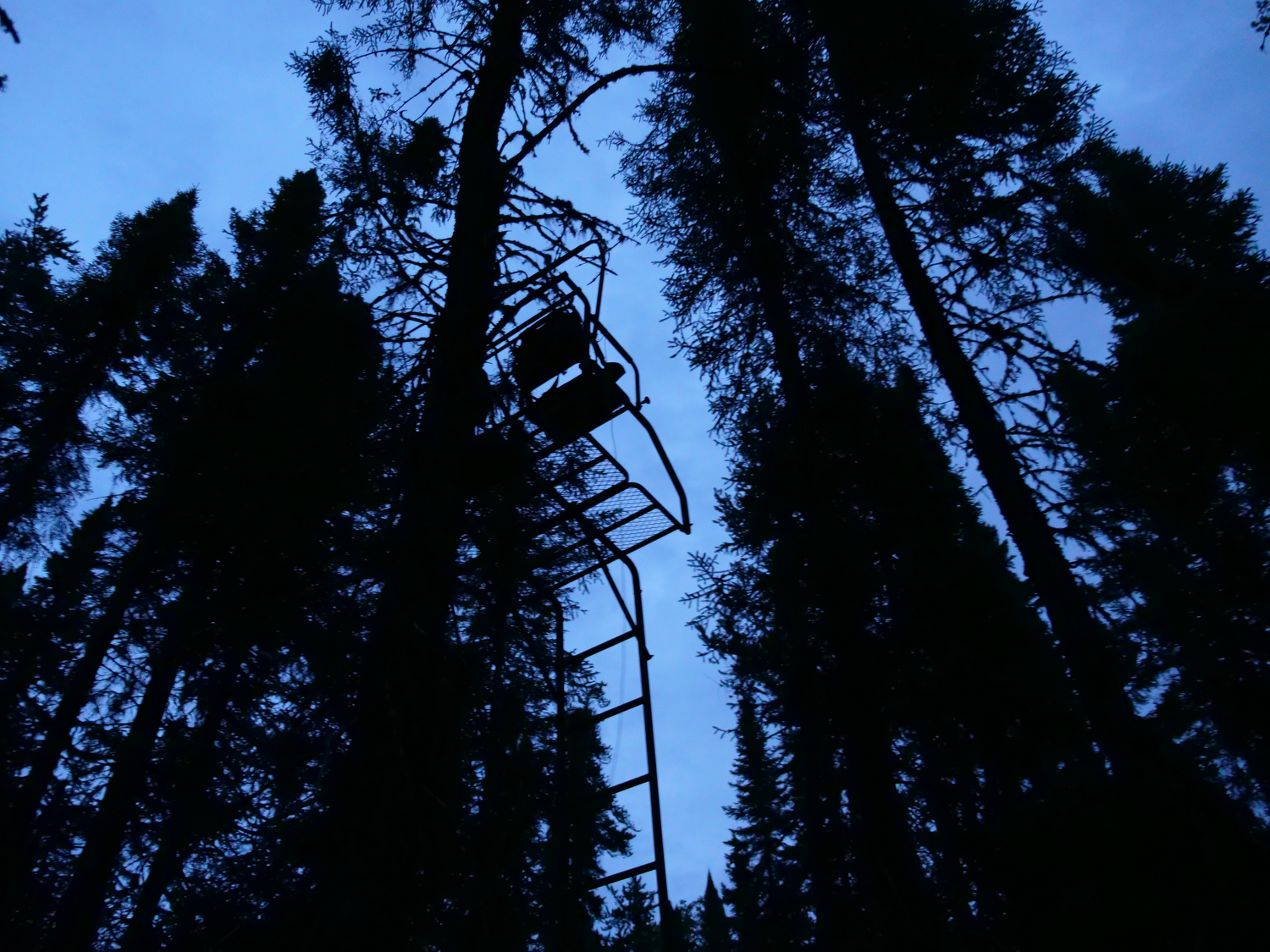
- 4K/60p video without time limits
- Fast, quiet performance
- 5-axis image stabilization
- Post focus, focus stacking, and 30-fps bursts (4K photo mode)
- Rugged design with excellent control scheme
- Area AF mode not as quick in video mode
- Smaller sensor than competing mirrorless cameras
Mirrorless cameras and DSLRS have been slowly encroaching on camcorder territory ever since the first DSLR with a video mode launched in 2008. With photo cameras now capable of shooting video, the line between camera and camcorder isn’t just blurring — it’s been crossed. And cameras like Panasonic’s Lumix GH5 are not only making consumer camcorders obsolete, with 4K/60p video capture, they are also becoming tools that even pro filmmakers are adding to their gear. The GH5 in particular is designed to be a versatile interchangeable lens camera that can handle both photos and videos, and suits users of all levels. Now that it’s for sale, it’s time to examine if one camera can truly handle the needs of both high-end still and professional video users, in our Panasonic Lumix GH5 review.
The GH5 packs fully-fledged video features inside a compact mirrorless (Micro Four Thirds, or MFT) body. It can shoot
But does picking up a camera so focused on video mean sacrificing a few photo-centric features in order to gain that video edge? In short, no. Besides being one of the best — in many cases, the best —
Compact, easy-to-control body
Looking at specs alone, it would be easy to confuse this for a video camera, but the GH5 looks every bit the part of a mirrorless still camera. The body’s slim mid-section and 1.6-pound weight is all mirrorless, but the comfortable grip, electronic viewfinder, and control dials are inspired from the style of DSLRs.
- 4. Lumix GH5
Like the highly lauded GH4 before it, it is certainly on the larger side for MFT cameras, and even bigger than some mirrorless cameras using the larger APS-C format.
At the top of the camera, a separate still shutter and video record button offer easy access to both shooting modes. A control wheel by the shutter and a second wheel at the back, near the thumb rest, make it easy to adjust aperture and shutter speed without taking your eye from the viewfinder.
In addition, a shortcut button for white balance, ISO and exposure compensation helps to expand the physical controls for “hands-on, eyes-off” operation. The traditional mode dial along with a dial for burst mode, timer, post focus, and 6K photo modes also sit on top, along with the first of five customizable function buttons.
The GH5 has both an electronic viewfinder and a 3.2-inch LCD. The 3,680k-dot viewfinder and the 1,620k-dot LCD offer an accurate representation of what’s in the frame, with focus peaking to lend a hand in scenarios that require manual focus. The LCD is both touch-sensitive and hinge mounted, which allows for a wide range of viewing angles, including front facing — great for selfies or vlogs.
To the right of the viewfinder, the GH5 has a number of focus controls. A switch swaps between manual focus, continuous, and single autofocus. That switch circles an autofocus and auto-exposure lock button. Next to those focus controls, there is a joystick, a feature not found in the predecessor.
The joystick makes it simple and fast to adjust the focal point in the pinpoint autofocus mode. Without it, moving the focus point would be a multi-step process. You can also tap the touchscreen to set your focus point, but with a 225-area autofocus system, the joystick allows for more accuracy.
While the specs may look more camcorder, the Panasonic GH5 looks every bit the part of a
The GH-series has always offered superior direct-access control, and the GH5 is no different, with plenty of on-camera buttons. The quick menu offers easy access to the settings that the physical dials and buttons don’t handle.
Video shooters will appreciate the HDMI port that offers clean,
The magnesium alloy body is weather-sealed, and true to Panasonic’s claims, our review unit sat through a rainstorm as we waited patiently to film some wildlife. While we didn’t much appreciate the wet and cold, the GH5 was unfazed by the water, although the lenses can still fog up. (Side note: Five-axis stabilization plus lens stabilization is very helpful when you are shivering.)
Fast, quiet performance
Like its predecessor, the GH5 can shoot 12 frames per second (fps) still photos with the focus fixed on the first frame, or 9 fps with continuous autofocus. That’s solid speed, but if that’s not enough, the 6K photo mode takes short 6K videos at 30 fps and extracts each individual frame, leaving you with a 30-fps burst, albeit with slightly lower resolution than the native burst mode.

The GH5 steps up from 49 autofocus points to 225. That opens up more possibilities for composition and allows for greater precision.
Autofocus in the GH5, in general, is fairly quick. The pinpoint and one-area focus modes are the quickest, most accurate options — they allow you to select a small area of the photo to focus on. Since the camera doesn’t have to decide between all those 225 points, speed inside these two options is in milliseconds. In pinpoint AF, the camera captured a sharp shot almost every time.
The 225-area autofocus mode, however, isn’t quite as quick. Since you haven’t told the camera what part of the image you’d like to focus on, the GH5 has to pick the focal point for you, and then focus. The performance is still fast for snapshots, however.
Photographers can also customize that autofocus with the Custom Multi Mode — along with picking the general area for the camera to focus on, this mode allows users to pick just how those focal points are laid out, whether that’s in a cluster, a straight line, or a completely custom configuration. AF speed for the Custom Multi is comparable to the 225-point autofocus mode. The GH5 also includes face priority autofocus and tracking, both of which performed well.
In video mode, the GH5 also has quick, accurate autofocus when using the one-area and tracking modes (pinpoint mode is unavailable with continuous focus, which you’ll want to make sure to switch on when shooting video). The tracking mode worked well as long as the subject stays within the frame and beyond the minimum focusing distance. One-area mode also worked well, adjusting quickly after zooming or panning.
The 225-area mode didn’t live up to the same accuracy and speed levels of the one-area and tracking modes while recording video. If the subject (or the camera) moved, the autofocus didn’t always pick up on the right spot, requiring a half-press of the shutter release to refocus.
The Panasonic GH5 doesn’t stretch itself too thin by trying to be both a camcorder and a camera.
This isn’t that bothersome; most advanced users will be using the tracking or one-area focus modes in video, or skipping them entirely for manual focus. But the difference is worth noting for some users — focus modes that allow the photographer to choose the area in video mode performs well, while the less-specific autofocus can leave some videos a bit soft.
(Note: Autofocus is one of the items that will see an improvement with new GH5 firmware launching in September 2017.)
When it came to wildlife photography, we were very happy with how quietly the camera performed. Turning on “silent mode” turns off any beeps and engages the electronic shutter for nearly noiseless operation. The GH5 isn’t absolutely silent in this mode as the lens’ autofocus motor and aperture blades still make noise, but the very soft clicks were not enough to scare off any wildlife.
The GH5 also uses a simplified wireless connection to your
After five generations of perfecting the formula, Panasonic has succeeded in not stretching the GH5 too thin by trying to be both a video camera and a still camera — performance is right on track in both areas. Stills shooting performance is quick for the category and, using the more specific area autofocus modes, video performance is very good for a camera at this price point.
Excellent, nearly endless 4K/60p video
The GH4 made waves for being the first
In fact, the video specs on the GH5 are so advanced, Panasonic might be a bit ahead of the time. When selecting any MOV or MP4 file type (the latter being the only option for
Professionals and other advanced users should have no issues editing video, since they’re more likely to have the equipment and software to handle such files. But for everyone else, while it’s not impossible, it could be a struggle. On a Mac we used, for example, we were able to preview
The GH5 has an unprecedented ability to keep shooting
Beyond
The video specs on the GH5 are so advanced they might be a bit ahead of the time.
Video also benefits from the GH5’s dual stabilization system, which combines sensor-shift stabilization with stabilized lenses (note: not all lenses are compatible). The dual stabilization allows for five-axis stabilization that, in still mode, lets you shoot at a shutter speed that’s five stops lower than you otherwise could.
The stabilization makes for much smoother handheld shots. Walking with the camera, you still get some motion, but not so much of the kind that leaves the viewer feeling seasick.
Quality is right on track with what we would expect from the GH5’s spec sheet. Colors are accurate and represent the original scene well. The
With the GH5, Panasonic also includes a mode (Rack Focus Transition) that allows videographers to create automated focus pulls without any extra gear. Using this feature, you can set up to three focus points and choose a focusing speed. While shooting, simply tap on any of the points on the touchscreen and the camera will refocus to that point at the speed you set. It is a nice extra for creating smooth focus effects without access to a follow focus system, which are usually pricey and complex to use.
The
Called “post focus,” the GH5 takes a short
Video from the GH5 is some of the most impressive we’ve seen from a prosumer
The version 2.1 firmware update, released in October 2017, added additional pro video features. Hybrid Log Gamma (
Image quality that measures up
As for photos, the GH5 uses a 20.3-megapixel Micro Four Thirds sensor (up from 16.4MP in the GH4) that creates excellent detail, enough to pick out more stars in the night sky than you can see with your own eyes. Low-light capability is also excellent, with decent noise levels up to ISO 3,200. It won’t match the extreme resolution or shoot-in-pitch-black capabilities of larger full-frame cameras, but it is certainly decent.
We tested the GH5 with the bright Lumix G Vario 12-35mm f/2.8 lens and found it to produce great results. The images have an excellent depth of field with nice soft backgrounds for close-ups and portraits.
Color is generally accurate under the standard color profile, while swapping profiles can yield a more specific look. RAW files have plenty of wiggle room to adjust color to match a specific style as well.
While images look excellent, keep in mind that this is a Micro Four Thirds camera. While Panasonic has filled the GH5 to the brim with extra features and pro-level specs, the sensor is smaller than most DSLRs and mirrorless cameras (exception is Olympus, which also uses Micro Four Thirds). It’s not a bad thing, but larger sensor cameras tend to offer better low-light performance, even more background blur, and a wider dynamic range, and there are several APS-C camera options available at the price point of the GH5. Still, both Panasonic and Olympus have done wonders with Micro Four Thirds, and the GH5 is one example.
While the high-end video options have been the most hailed features of the GH5, the camera certainly isn’t a slacker for still photos.
Our Take
In our hands-on experience, the GH5 lived up to the big expectations set by the long list of specifications, both as a still camera and a video camera. The GH5 may have a smaller sensor than competing mirrorless cameras from Sony and Fujifilm, but it’s packed with features that much of the competition can’t touch. Like the GH4 before it, the GH5 has set the stage for the future, and other manufacturers will now be playing catch-up.
Is there a better alternative?
The GH5 has a few big firsts for video from a dedicated camera. For users that really just want to shoot photos, it’s probably overkill — several superb cameras at a similar price point offer a larger sensor, like the Nikon D500, Fujifilm X-T2, or even the full-frame Sony A7 II. But, if the intent is to shoot both photos and videos, the GH5 has a clear edge. It has a much longer record time for that high resolution, and adds extra features like in-camera follow focus and post focus on top of that. Want to take your budding YouTube channel to the next level? This camera will take you there, without having to resort to ridiculously expensive pro-level cinema cameras.
However, it didn’t take long for Panasonic to release an even more video-focused version of the GH5 — the GH5S. This 10MP, $2,500 sister camera boasts improved low light performance and reduced rolling shutter, but also sacrifices in body image stabilization. Studio and cinema pros may prefer it, but the GH5 likely remains the better option for most users.
Let’s also not forget about the older GH4. While it isn’t as strong as the newcomer, it’s still an excellent
How long will it last?
The GH5’s predecessor launched in 2014. If Panasonic follows the same update schedule, a GH6 will probably hit the market in 2020. Panasonic has already announced one major firmware update for the GH5, and others will likely arrive throughout its lifespan. This is a flagship camera for Panasonic, and the company appears to be supporting it as such.
Should you buy it?
If you are looking for a camera that shoots Hollywood-caliber blockbusters during the week but can still handle your kid’s soccer game on the weekend, then the Panasonic GH5 is hard to beat. It is likely the best
The GH5 offers excellent video, solid photos, and a staggering set of extra features, including post focus and 6K photo. That said, if you are looking for a camera just to shoot still photos, the $2,000 price tag is probably too expensive for a small-sensor camera. While the GH5 is worth the cost for filmmakers, there are a number of cameras with similar features for still photos and larger sensors (or lower price tags). Buying the GH5 and not using that
And remember, pro video cameras and camcorders cost significantly more, and that doesn’t include the lenses you may need. When you look at it that way, the GH5 is actually reasonably priced.
With the GH5, Panasonic continues to impress with a still camera that serves double duty as a cinema camera. It won’t be a must-buy for everyone, but it is a major technological achievement and a very capable tool for high-end content creators.
Update: Panasonic added
Editors' Recommendations
- Smaller and cheaper, the full-frame Lumix S5 is exactly what Panasonic needed
- Sony’s A7S III is the ultimate 4K video camera, five years in the making
- The Nikon Z 5 doubles down on SD card slots despite its entry-level price
- Panasonic takes on Sony in the vlogging camera game with compact Lumix G100
- The $600 Panasonic Lumix S 20-60mm is a unique, affordable zoom

































